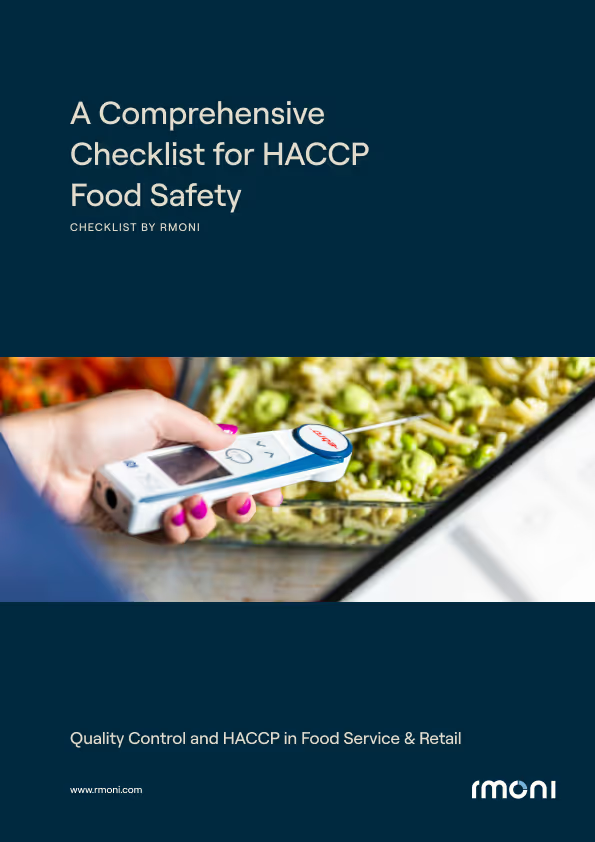HACCP Food Safety: A Comprehensive Checklist
To help you prepare for an HACCP audit, we’ve compiled a comprehensive checklist for food service & retail businesses that want to comply with food safety regulations.

Food safety management system HACCP
HACCP, or Hazard Analysis and Critical Control Points, is a food safety management system that is designed to identify and control potential hazards in the food production process.
To ensure your HACCP plan meets modern standards, we’ve created a comprehensive checklist for you to download and use at your convenience. But first, let’s take a look at the HACCP system itself.
What is HACCP?
HACCP was developed by NASA in the 1960s for ensuring the safety of food for astronauts, and has since become a widely adopted standard in the food industry. It’s important for food safety because it helps to minimize the risk of foodborne illnesses by proactively identifying and controlling potential hazards at each stage of the food production process.
This includes biological, chemical, and physical hazards, such as bacteria, toxins, and foreign objects. By using the HACCP approach, food businesses can ensure that the food they produce is safe for consumers to eat.
Why is HACCP important in food safety & retail?
HACCP is quite a big deal because it helps ensure the food we eat is safe and won't make us sick. It's like a step-by-step plan to identify any potential hazards in the food production and retail process, and then put controls in place to prevent those hazards from happening.
It's also important because it helps companies comply with food safety regulations and shows customers and regulators that they take food safety seriously. Plus, using HACCP can help maintain the quality of food, which is a win-win for everyone.
All in all, HACCP is crucial for keeping us safe and healthy, and for making sure the food we eat is top-notch.
The 7 Principles of HACCP
To create an effective HACCP plan, follow these seven principles:
1. Hazard analysis
Identify potential risks associated with food products, including biological, chemical, and physical hazards.
2. Critical control points
Identify areas where control is possible to prevent food safety hazards.
3. Critical limits
Determine minimum and maximum limits to prevent hazards and ensure safe conditions.
4. Monitoring
Continuously observe and record procedures to ensure critical control points are within safe limits.
5. Corrective actions
Create and follow predetermined actions if critical limits are not controlled.
6. Verification
Regularly review the plan and systems in place to take preventive actions, not reactive ones.
7. Record-keeping
Centralize documentation of the HACCP system, including the hazard analysis, HACCP plan, summary, and support material.
What are the 12 steps of HACCP?
To fully implement HACCP according to legal requirements, the a 12-step process should be followed, which looks like this:
- Assemble your HACCP team
- List all the ingredients, products and processes
- Identify the end-consumer
- Construct a complete flow diagram for each final product
- Check and validate the flow diagram is accurate
- Analyse each flow diagram for potential hazards
- Establish your Critical Control Points (CCPs)
- Determine critical limits for each CCP
- Monitoring each CCP’s controlling measures
- Set up actions for correcting exceeded critical limits
- Set up procedures that verify the HACCP system is effective
- Set up documentation and due-diligence procedures
How to automate HACCP with a digital solution
Digital HACCP registration allows for all the necessary documentation of processes and record keeping, regarding your HACCP plan, to be stored digitally. This means that information such as checklists, CCPs and data from wireless sensors are all stored and accessed digitally.
In order to successfully implement HACCP and make executing the necessary procedures feasible, digital HACCP registration is preferred over paper documents. If you’re not ready to automate HACCP yet, here’s a comprehensive manual checklist.
A comprehensive checklist for HACCP in food service & retail
To help you prepare for an HACCP audit, we’ve compiled a comprehensive checklist for food service & retail businesses that want to comply with food safety regulations.
This checklist is relatively extensive, and will help you on your way to prepare for HACCP audits. However, do please refer to the official HACCP guidelines set in your country, as this checklist is not in any way intended to replace official guideline regulations.

You can find the full HACCP food safety checklist in our downloads section.

